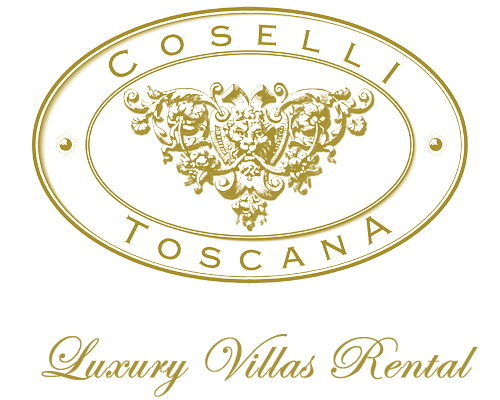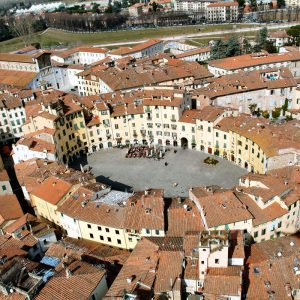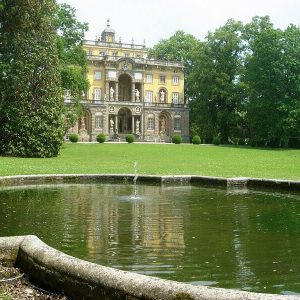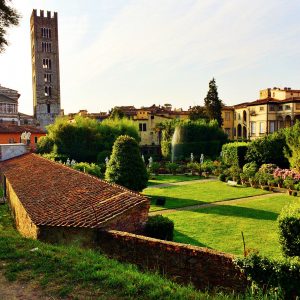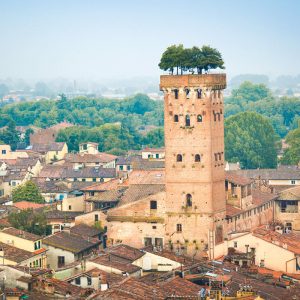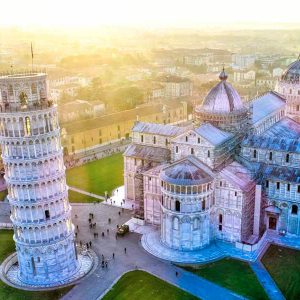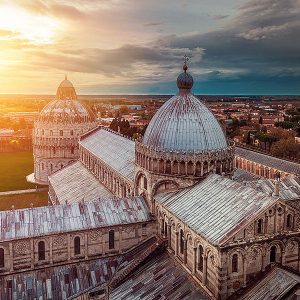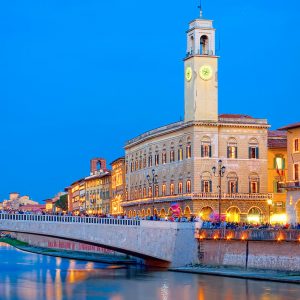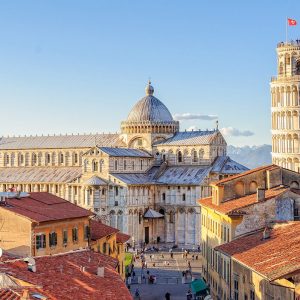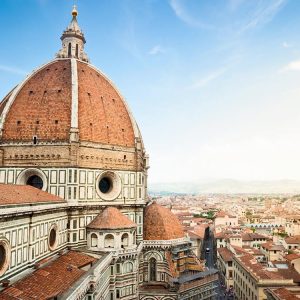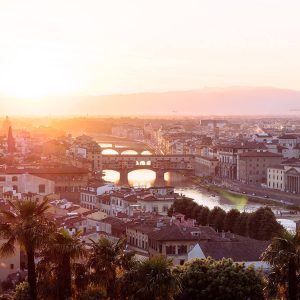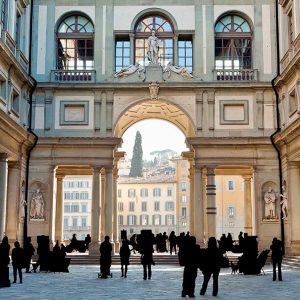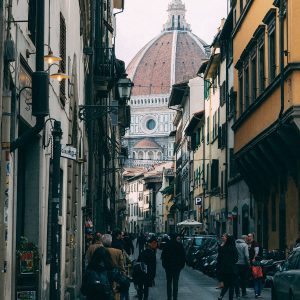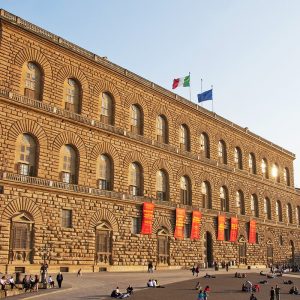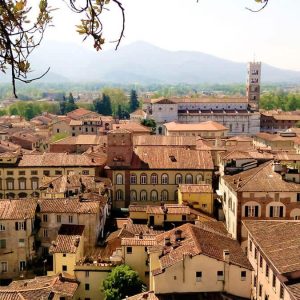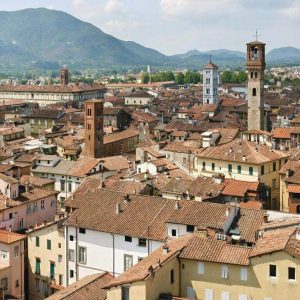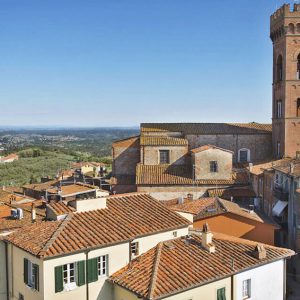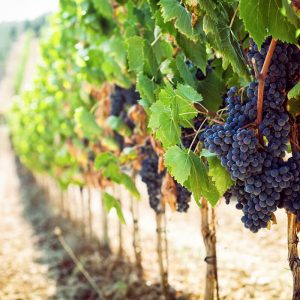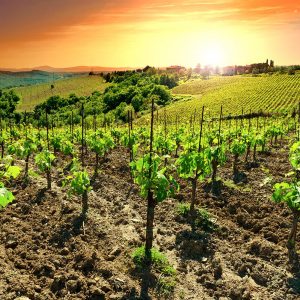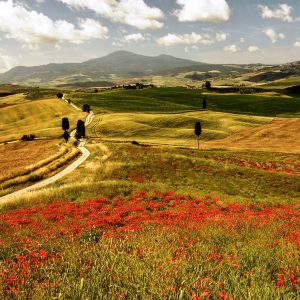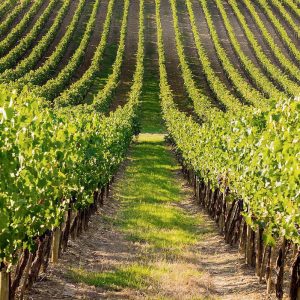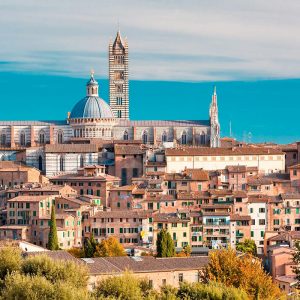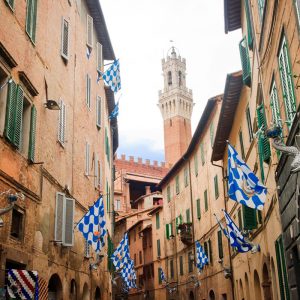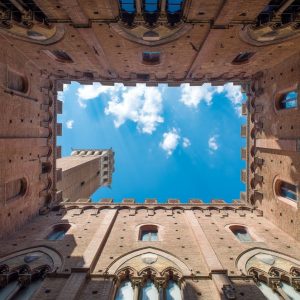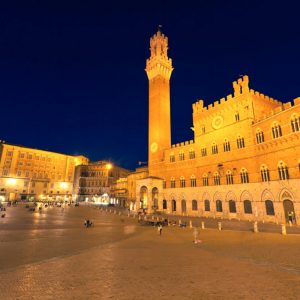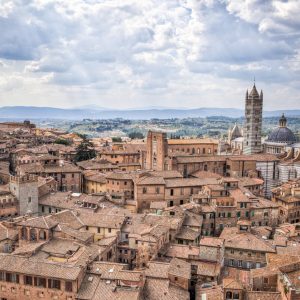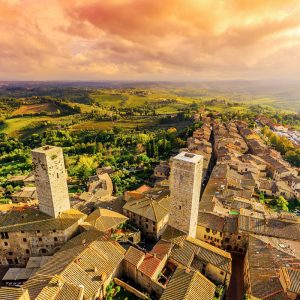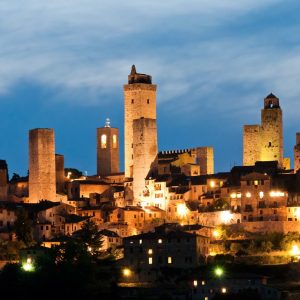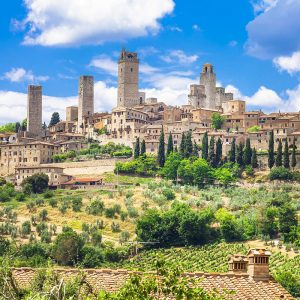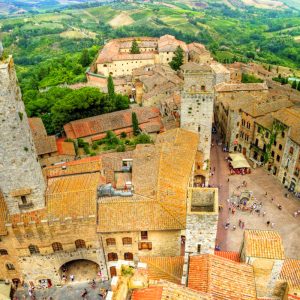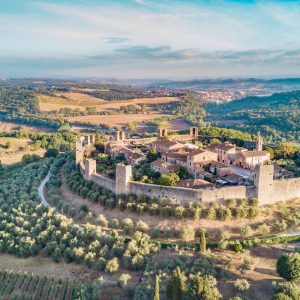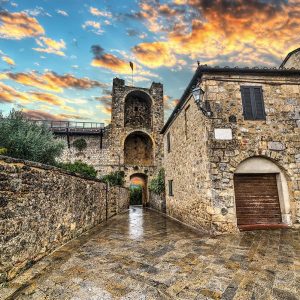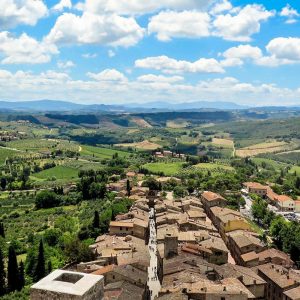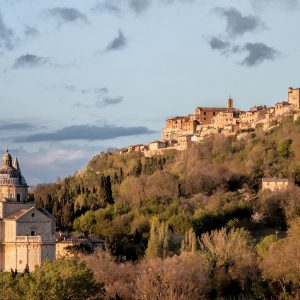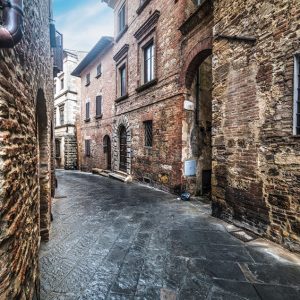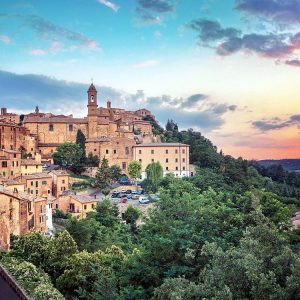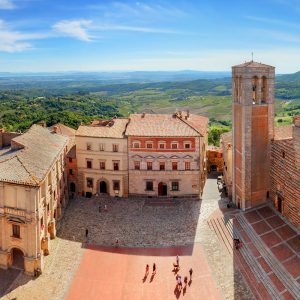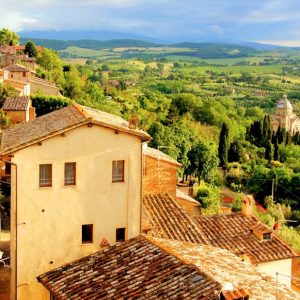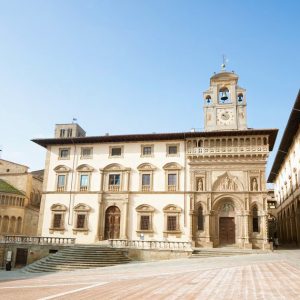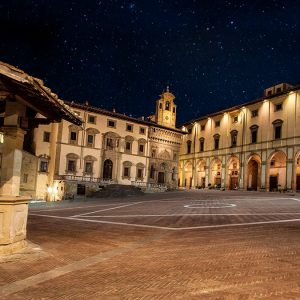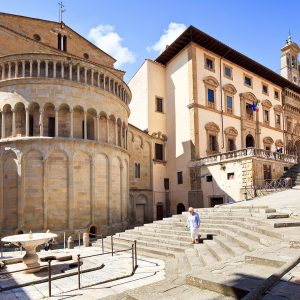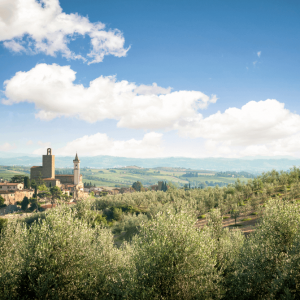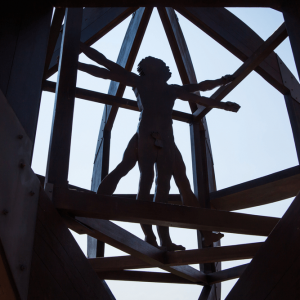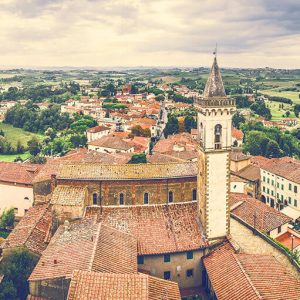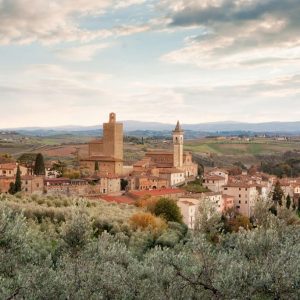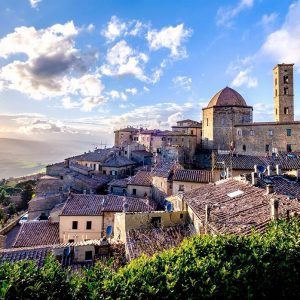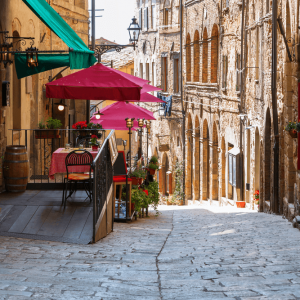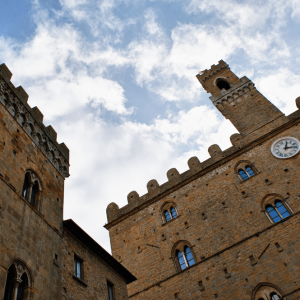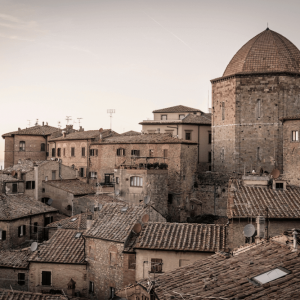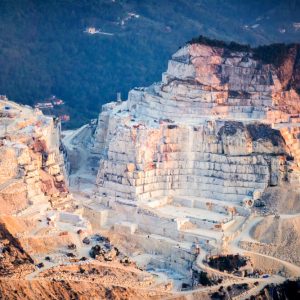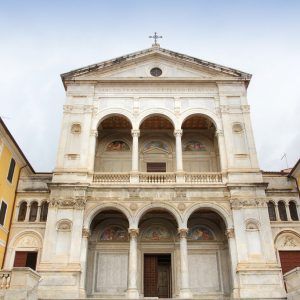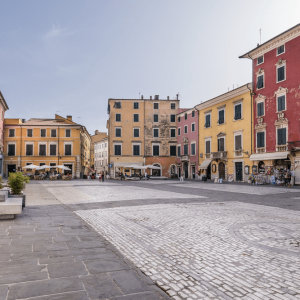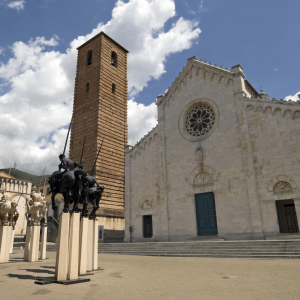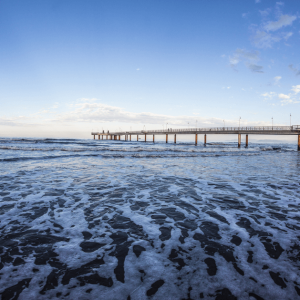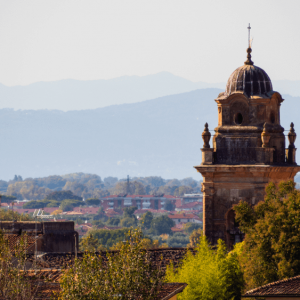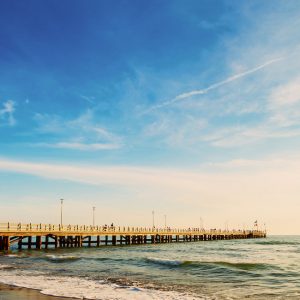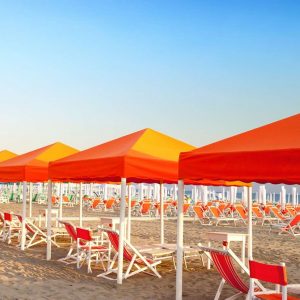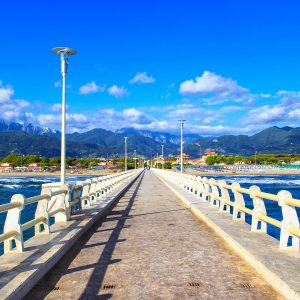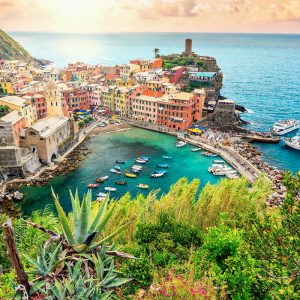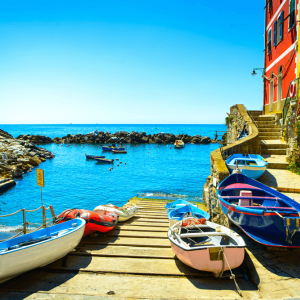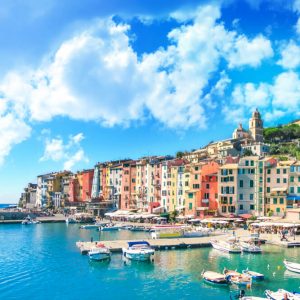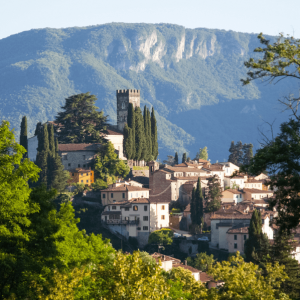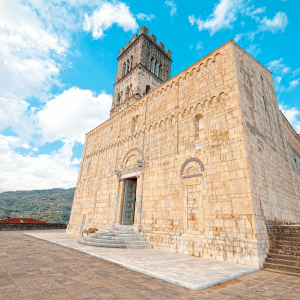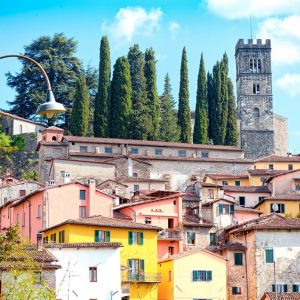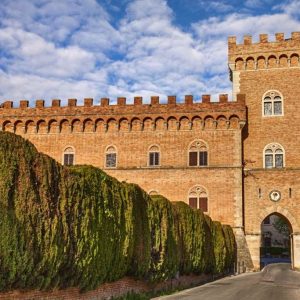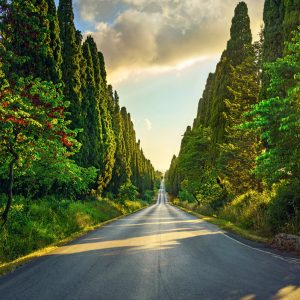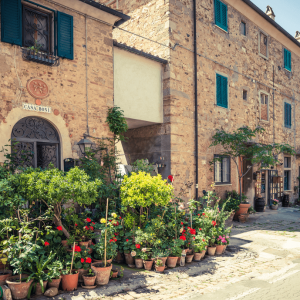Coselli Collection » Concierge & Services » Tuscan guided tours
Luxury villa for rent in Lucca, Tuscany
Guided Tours in Tuscany
coselli collection
Find out more about our territory
coselli collection
LuccaCity of a hundred churches
Lucca has made a virtue of the necessity to stay in the political shadow of his three mighty competitors Pisa, Florence and Siena. Instead of striving for unlikely military success, the small town has always looked at economic success. Even today, it boasts a general wellbeing hardly matched by any other Tuscan town. Throughout this medieval city you’ll find monuments representing all the various historical epochs Lucca has lived through, beginning with a Roman amphitheater through the centuries and styles, you’ll reach the Medieval era, and Lucca’s true treasures.
Start your tour where the residents of Lucca spend their free time: on the city wall topped by a line of shady trees. First stop is the San Frediano church with its magnificent thirteenth-century mosaic representing Christ in Majesty. Next, visit nearby Piazza del Anfiteatro, the most beautiful square of Lucca. Passing by the elegant shops of Via Filungo and through small, typically medieval streets reach the Duomo which houses the famous Volto Santo and the splendid Ilaria del Caretto sarcophagus, a masterpiece of Jacopo della Quercia. Passing Piazza Napoleone arrive at piazza San Michele, the central civic square of Lucca since Roman times.
If you are tired, opt for a bike tour in Lucca with an easy ride on top of its impressive city wall, overshadowed by old trees. From this vantage position enjoy beautiful views of the medieval center and its surrounding landscape. Then head off for the town’s most famous church, the San Martino cathedral (inside visit) and the adjacent Piazza Napoleone. Passing Piazza San Michele – the antique town center of Lucca – reach The Guinigi Tower and Piazza dell’Anfiteatro. Finish with Piazza S. Frediano with its thirteenth-century mosaic. Do not leave the city before visiting the home of the famous composer Giacomo Puccini and other well-known musicians.
After visiting Palazzo Pfanner in the center of the city, why not see other magnificent Villas outside the city center in the countryside of Lucca. The numerous villas and parks built on commission of rich noble families in the hilly countryside around Lucca are a unique architectural and botanical treasure. Our guided tour encompasses a detailed presentation of two villas and their parks: villa Torrigiani and villa Reale di Marlia. Of course, if you wish, we will also guide you in any other villa and its garden. Choose among from villa Grabau, villa Oliva, villa Mansi o villa Bernardini.
PisaThe city that rises above banks of Arno
Discovering Pisa means getting lost in squares packed with students who fill up the nighttime locales, bringing new life to the medieval city. Pisa offers definitely more than just a “Leaning Tower”. Three thousand years of history, pioneering science and trendsetting art make Pisa an obligatory stop on every trip in Tuscany.
With our guide, you will discover Pisa’s most important monuments and squares: our walking tour starts with a visit to the world famous Campo dei Miracoli (Field of Miracles) with its unrivalled quartet of medieval masterpieces: Leaning Tower, Cathedral (inside visit), the Campo Santo (inside visit) cemetery, Baptistery and its unique acoustics – if any lucky people among you get the chance to attend a concert inside, you’ll hear the walls act almost as an instrument, with sounds continuing to echo and bounce up to a minute after they have been sung.
FirenzeCradle of the Renaissance art
Florence, capital of Tuscany the Renaissance city is a treasure trove of art with an astonishing contemporary vibe. Beyond the extraordinary artistic heritage, a testimony to its centuries of civilization, the best way to enjoy Florence is to stroll along the riverside avenues at sunset, or to get lost among the city’s myriad alleyways of the bohemian Oltrarno or the narrow little streets of San Niccolò, where it feels like you have ended up in another time along its centuries-old walls.
Start your tour with a visit to Piazza Santa Maria Novella and its beautiful church. On a leisurely walk through the historic town center, visit Piazza della Repubblica, the vivid Porcellino market and Ponte Vecchio, constructed in 1325. Walking along the banks of the river Arno reach the famous Uffizi art gallery and the nearby Piazza della Signoria, the heart of the political Florence. Here Savonarola lit his bonfire of vanities. It is hard to leave the amazing beauties in white marble, such as Giambologna’s “Sabinas’ Abduction” or Michelangelo’s “David”. But who would not like to see the highlight of this walking tour, Brunelleschi’s majestic Cathedral with Giotto’s Campanile or the famous bronze doors of the adjacent Baptistery!
Visit The Palatine gallery which is located on the first floor of the Pitty Palace, which was formerly the residence of the grandukes of Tuscany and later of the King of Italy. Created in the eighteenth century, the museum displays a vast array of paintings of Raphael, Titian, Caravaggio, Rubens, Pietro da Cortona and other Italian and European painters masters of the Renaissance and Baroque periods.
In Pitti Palace you can visit also The Modern Art Gallery The Silver Museum and Fashion Museum which is the only museum dedicated to the history of fashion in Italy and one of the most important of its kind worldwide.
Montecarlo Charming town in the hills
Montecarlo is a charming town immersed in the hills of the Lucchesia characterized by its extensive rolling vineyards and significant wine production.
Perched on a hilltop, the beautifully preserved historical center is still ringed by splendid city walls. The town’s symbol is an imposing fortress, the Rocca del Cerruglio, constructed between the fourteenth and sixteenth centuries. A massive and formidable triangular-shaped structure, it comprises a semicircular-shaped main tower, known as the mastio, and two square-shaped towers that connect it to the curtain walls, the Tower of the Apparition and Tower of Saint Barbara.
Montecarlo’s top sights worth seeing include the Collegiate Church of Saint Andrew (Chiesa Collegiata di Sant’Andrea), the not-to-be-missed parish church Pieve di San Piero in Campo, dating back to 846, and the tiny but enchanting theater Teatro dei Rassicurati, which was frequented by the composer Puccini. Nature lovers can lose themselves amongst the silence and greenery on trails through the region’s vineyards and olive groves, such as the inviting path to San Martino in Colle, which reveals an enormous ancient oak tree more than 500 years old growing on the hilly slopes. According to legend, this was where local witches gathered to perform their rites, which is why it is now known as the “Witches’ Oak”.
ChiantiBetween Florence and Siena
The Chianti Classico, an area between Florence and Siena, owes its international reputation mainly to the excellent wines that grow amid its enchanting hills. Places like Greve in Chianti, Gaiole, Radda and Castellina in Chianti are the pillars of the world of “Gallo Nero” (black rooster), a quality label awarded by the area’s best wine producers. In addition to vineyards and wineries Chianti area offers beautiful old country churches, the so called “Pievi”, well-preserved medieval hamlets and powerful castles, evidence of centuries of fierce battles for supremacy in this strategically important area.
The best way to not miss out on anything in the region is to travel the Chiantigiana, adored by motorcyclists, linking Florence to Siena. Stopping along the way means seeing must-see villages like Greve, with its curious, triangular piazza surrounded by colonnades, Castellina and its fortress that houses the archaeological museum, and many more typical Tuscan parishes, like Montefioralle and Panzano. While lost in the winding alleys of these hamlets, luck strikes when you find yourself in a shop full of wine bottles or in a traditional butcher’s shop, before eventually arriving unsuspectingly at a local Wine Museum.
SienaWorld Heritage Site
Together with Florence and Pisa, Siena is one of the leading art cities in Tuscany. The three hills amid which the city rests rise up like an idyllic film set, the old boundaries soften like the past into a countryside that still mostly looks as it did in the 14th century, and the conservation of a unique, coherent medieval architecture is one of the main reasons to visit a charming city conscious of its fragile equilibrium: it was the first municipality in Europe to stop traffic from entering the old city centre, back in 1966.
Start a tour with a visit to San Domenico, a church much frequented for its venerated relics of Saint Catherine, patron saint of Italy and Europe. Then go towards for the magnificent palace of the Monte dei Paschi bank, founded in 1472 – the oldest bank in Europe. From there reach nearby Piazza del Campo, the unrivalled center of vivid city life. Here the guide explains the rules – and tricks!- of the Palio, Siena’s breathtaking bareback horse race. With a stop at the Chigi-Saracini Palace we finally reach the Duomo with its marble pavement made with a startling sequence of 56 marble panels.
The Palio and the life in a Contrada: The epitome of popular culture in Siena is the Palio, the bareback horse race on the Piazza del Campo. The Palio di Siena (known locally simply as Il Palio) is a horse race that is held in Siena, Tuscany twice each year, on July 2 and August 16. This is not a mere touristic event, but a significant part in the life of the city today as it did centuries ago. Visitors to the city can assist for free from the center of Piazza del Campo (no chairs, the first who arrives, gets a place) or pay a ticket to get a more comfortable position from the balconies of the buildings overlooking the show. Ten horses and riders, bareback and dressed in the appropriate colours, represent ten of the seventeen contrade, or city wards.
The Palio held on July 2 is named Palio di Provenzano, in honour of the Madonna of Provenzano, a Marian devotion particular to Siena which developed around an icon from the Terzo Camollia. Other Palios are sometimes held in May and September, as the extraordinary events approved by the Municipality.
San GimignanoOnce part of the Republic of Siena
San Gimignano rises on top of a hill 334m above sea level, clearly visible in the distance with its many towers. Today 13 towers remain of the 72 towers of the fourteenth century, when every well off family built a tower to show its economical power (many of them are still visible in the buildings, even if they were cut off).
The first towers rose wide apart in a rarefied urban fabric looking very different from the nowadays compact centre. Towers were used in a different way. Rooms were very narrow, generally 1x2m; there were a few openings, and the walls, about 2m thick, assured cool temperature in summer and hot in winter. Almost all the towers were built next to other buildings in perishable materials such as wood and earth. In medieval times the tower was the higher symbol of power, mainly because the building process was not simple or cheap at all. Materials needed to be dug and transferred to town, and the building site arranged. Only the richest families of merchants and moneylenders could afford the works of construction.
No matter how short your visit in San Gimignano might be, you must visit the cathedral to admire the marvelous cycle of frescoes that recount stories from the New and Old Testaments painted by illustrious artists of the 14th-century Sienese school and the extraordinary Renaissance jewel, the Chapel of Santa Fina and if you have time head to the Museum of Sacred Art next door to admire the exquisite “Madonna of the Rose”.
MonteriggioniFrom the top of a hill
Monteriggioni, whose stone halo shines from the top of a hill, is one of the most memorable towns in all of Italy. Gateway to the Middle Ages. It dates way back, perhaps even settled in the 8th century BCE, as evidenced by the settlement unearthed near Campassini and the vast Etruscan necropolis Casone.
The tiny hamlet is barely two streets wide and has perfect city walls surrounding the compact city on a hill. The town was established in 1214 by the Sienese to aid in their battle with Florence. You can walk along the ramparts of the circular town walls and see the 14 towers which Dante compared to the Titans guarding the lowest level of Hell. There are two gates in the walls and the main street runs from one gate to the other through the town.
MontepulcianoBeautiful medieval village
Montepulciano rise on the narrow chalk hill where the Val d’Orcia and Val di Chiana meet. This beautiful medieval village can be found in what seems like a postcard-perfect landscape, your mind conjuring up the classic idea of the Tuscan countryside no matter which direction you look in, with the green waves of the hills and golden fields dotted with cypress trees.
The best way to discover the elegant historic center atop the hill is on foot: as you walk along, you’ll come across mighty Renaissance palaces before reaching – at the highest point of Montepulciano – the main piazza with the Duomo, the town hall and Palazzo Nobili Tarugi.
Admire the beautiful temple of the Madonna di San Biagio. The travertine used to construct the building at the beginning of the 16th century can be seen far off amongst the greenery of the countryside, offering the best welcome for anyone who decides to spend an afternoon strolling through these streets or soaking in the hot sulphurous waters in the nearby Thermal Spa.
ArezzoAncient city
Not everyone knows that Arezzo is an ancient city, older than Alexandria in Egypt! To discover Arezzo you need to have a smattering of understanding about its past. Arezzo was one of the main Etruscan city-states. Later in life it became a Roman city of strategic importance, a nerve center of vibrant commerce, a place brimming with monuments such as the Amphitheatre, whose remains can still be seen today. Back in those days Arezzo’s foundries were well known, as too were the city’s artistic workshops of “coralline” pots, which were painted red and whose decorative technique extended throughout the Roman world.
Our guided walking tour in Arezzo’s historic center encompasses the visit of the church of San Francesco with its frescos by Piero della Francesca, the Pieve Santa Maria Assunta, the Piazza Grande bordered by Vasari’s loggia, the Cathedral, the church of San Donato, the Palazzo del Comune (town hall) and the church of San Domenico housing a Crucifix by Cimabue.
VinciAUTHENTIC HILL TOWN Birthplace of Leonardo da Vinci
Vinci is situated in the hills of Montalbano, a green area divided between the provinces of Pistoia, Prato and Florence. The municipality of Vinci is part of the province of Florence. There are plenty of things to see in Vinci and many of them are related to Leonardo’s life: the house in which he was born, just 3 kilometres from Vinci in the middle of the countryside, the church where he was baptised, and the museum and the library that take his name.
Vinci dates back to the early middle ages, when Vinci was under the rule of the Guidi counts. In the town centre you’ll find the Guidi castle, also known as the “castle of the ship” because of its elongated shape and the tower shaped like a sailing vessel. It contains the Leonardo museum and bears painted and sculpted coats of arms as well as a ceramic Madonna and Child by Giovanni della Robbia, made in 1523.
Do not miss a wooden representation of the Vitruvian Man, a drawing by Leonardo in which he represented a man with the ideal proportions. The statue – called “L’Uomo di Vinci” – was made by Mario Ceroli and donated to the town by the artist in 1987. The wooden statue is situated in a terrace from which you can enjoy stunning views of the surrounding hills.
VolterraTown of Etruscans and snow-white alabaster
Volterra is the town of the legendary Etruscans and the snow-white alabaster. One of the aspects that really sets Volterra apart is the fact that it is Tuscany’s oldest continuously-inhabited town, with settlements documented since 1,500 B.C. The town is essentially a microcosm of the historical developments of the region of Tuscany, and thus enables you to better understand the Tuscany as a whole in a context that is, at the same time, enchanting and still off-the-beaten-track.
From the top of the medieval town wall with a view of the untouched Tuscan landscape, on bright days, you can even see Corsica from there. In a 5-minute walk, you reach Arco Etrusco, the 2300-year-old Etruscan gateway. Through small streets and peaceful little squares, there is the Roman theatre and the adjacent thermal baths.
The culmination is the medieval Piazza dei Priori, flanked by the town hall and the Duomo with a famous thirteenth century sculpture of The Deposition and works of Benozzo Gozzoli and Fra Bartolomeo. Tour could be concluded with a visit of the Baptistery situated in front of the Duomo.
CarraraCarrara marble quarries and sculpting class
Carrara was built at the bottom of its marble mountains, it is located along coast of northern Tuscany next to the boundary of Liguria region. Behind Carrara the three main marble valley disclose themselves: Colonnata, Miseglia and Torano which take the name from their main villages.
Throughout 2000 years it has been excavated this white unique stone. Visit the amazing marble mountains of Carrara with small vans and learn how to carve a piece of Carrara marble with the help of a real sculptor. Have fun to carving your own marble tile with a hammer and chisel, and go back at home with your personal hand made marble work.
Afterwards ride all the way up to an altitude of nearly 1000 meters to admire unique panoramas, and have a general recap of the day by visiting an exhibition of tools and machinery to answer to the typical questions like: “How did the Romans do?” “How did Michelangelo do to transport such heavy weights…”
Lunch is arranged in Colonnata, a quaint quarry-men’s village located in the hearth of the marble valleys.
Pietrasanta Perfect destination for art enthusiasts
The fascinating city of Pietrasanta is the perfect destination for art enthusiasts, both classic and contemporary. A gathering place for artists from all across the world and a true hub for international sculpture, in recent decades, Pietrasanta has become a something of an open-air museum thanks to the generosity of artists of international reputation like Igor Mitoraj, Marcello Tommasi, Fernando Botero, Ivan Theimer and others. Here you can admire, among the many galleries and public piazzas, an uninterrupted continually renewed exposition of contemporary art and sculpture of the highest levels.
The city has earned itself the nickname “Little Athens” thanks to the concentration of artists that have decided to settle down here over the years. Our guided walking tour starts at Porta Pisana from where we reach the cathedral entitled to Saint Martin. A few steps from here we find the centaur, a magnificent bronze statue of Igor Mitoraj. In Via Mazzini we then visit the church of the Misericordia, which houses two splendid frescoes of Fernando Botero. Passing the house of Father Eugenio Barsanti, together with Felice Matteucci known as the inventor of the internal combustion engine, we finally reach the piazza Matteotti with its works of Pietro Cascella and Fernando Botero.
Forte dei MarmiVersilia coast
A seaside resort looking out onto the southernmost part of the Ligurian Sea, it takes its name from the fortress in the centre of the town, which Grand Duke Peter Leopold commissioned to defend the port, and from the marble that used to be carried down from the nearby Apuan Alps to the wharf, from where it was shipped abroad.
The symbol of Forte dei Marmi, standing right in the heart of the town, is “Il Fortino”, the Grand Duke’s fort erected in the late XVIII century, now surrounded by a modern urban centre, its grid of tree-lined streets giving this town a fashionable but relaxing feel. The building was refurbished in 2004. Its interiors are also interesting as home to the Museum of Political Satire and Caricature on the first floor, one of the world’s most important museums of its kind in. Important temporary exhibitions are set up on the ground floor. A XVIII-century well can be found on the side of the Fort, in Piazza Garibaldi.
On the seaside, 300 metres off shore, is the loading wharf, which was used to load the big blocks of marble that were shipped all over the world, now used as a tourist attraction and as a temporary mooring for a local ferry to the Cinque Terre.
Cinque TerreFive tiny villages hanging on the cliffs of eastern Liguria
Cinque Terre are five tiny villages hanging on the cliffs of eastern Liguria: Riomaggiore, Manarola, Corniglia, Vernazza, Monterosso. Included in the World Heritage List since 1997, and National Park since 1998, they are not just a pretty place to photograph, but an experience to prove: stroll in the shady alleys, enjoy the ambiance, the colors, the perfumes of these places, taste authentic local flavors, are definitely unmissable.
Even the surroundings offers interesting opportunities for a visit: The Gulf of Poets with Lerici and Portovenere (World Heritage Site), Sarzana lovely medieval town, La Spezia with its colorful food market and imposing palaces. Furthermore don’t miss Carrara and its amazing marble quarries, or the green valleys of Lunigiana with Pontremoli and Vara with Varese Ligure. Explore 3/4 villages according to the dimension of your group and your time availability. Enjoy the spirit of this unique region: walk in the villages, have a ferry ride and try local delicacies.
Riomaggiore, stroll along the scenic path that links the new and old side of the village. Visit the ancient church of St. John the Baptist and end up in the main street. After some time at leisure move to pier for taking the ferry to Monterosso.
Manarola, you could walk for a short leg along the Via dell’Amore (still closed for a rock slide), and all the way up to St. Lawrence church then along the path that runs through the vineyards. For a less tiring version of the visit just stroll to the Marina and enjoy the best view of the village from there.
Vernazza, another lovely village. The all look the same, but each one has its peculiarities. The alleys of Vernazza are something special, set like a maze; they bring you back in time to the origin of these communities.
Monterosso, it’s the largest village of Cinque Terre it offers a pretty pebble beach, easy walking streets, good variety of eateries for all tastes.
Corniglia is the smallest of the five villages and even the most isolated one, ferries don’t stop there and from the train station to the village take the bus or climb a long flight of steps to get there.
BargaTuscan hidden gem
This Tuscan hidden gem is a medieval town nestled in the heart of the Serchio Valley, the main town of the “Media Valle” (mid-valley) in the province of Lucca. Barga is located in the Tuscan-Apennine hills at 410 meters above sea level, dominated by the Pania della Croce, a mountain in the Apuan Alps. For its historical, artistic and touristic importance, Barga has received several awards, including “One of the Most Beautiful Villages in Italy,” “Orange Flag Touring Club” and “Cittaslow,” all leading standards in the tourism industry.
Barga boasts many ancient traditions dating to the early-medieval Longobard era (6th-8th centuries), as also noted in the town’s layout, which has remained virtually unchanged since then. Narrow streets interweave the irregular-shaped buildings in with a web-like form. In the Middle Ages, Lucca and Pisa fought extensively over control of the flourishing town and its surrounding territory. Florentines also battled for the dominion of Barga, which later passed to the Duchy and Grand Duchy of Tuscany. Hilly Barga lies 35 kilometers north of Lucca in the valley of the Serchio, a particularly striking and beautiful part of Tuscany.
Starting from Lucca, we quickly reach Borgo a Mozzano and its amazing ‘Devil’s Bridge‘. After a short stay, we proceed along the river Serchio towards Barga. Walking through narrow medieval streets we arrive at Barga’s main attraction, the cathedral dedicated to Saint Christopher. The church was built with travertine and preserves a masterful pulpit from the workshop of Guido Bigarelli.
On your way there do not forget to stop at the DEVIL’S BRIDGE – original name Maddalens’s bridge. When you see it from the road you will notice the different shape of this bridge with its asymmetrical arches but the impressive thing is walking through it. The Devil’s Bridge was first built in the 12th century and it is a great example of medieval engineering. It is 40 meters (131 feet) wide and 18,5 meters (60 feet) high and up there you can enjoy the clean water of the Serchio river.
BolgheriWine rout of the etruscan coast
In the last two hundred years, the area of Bolgheri has inspired poets, wine makers and travelers alike. Bolgheri’s magnificent cypress alley was immortalized in a poem written by Giosuè Carducci in 1886 and Mario Incisa della Rochetta revolutionized here the Italian wine production with his worldwide admired Sassicaia.
On this wine tour we first bring you to Bolgheri where you will have plenty of time to stroll around the village before we invite you for a tasting of Sassicaia. After lunch we will visit the estate of a famous winemaker before we return to the wine route (strada del vino) which connects Bolgheri with Castagneto Carducci our last stop. Here you will enjoy unforgettable views of the surrounding landscape.

